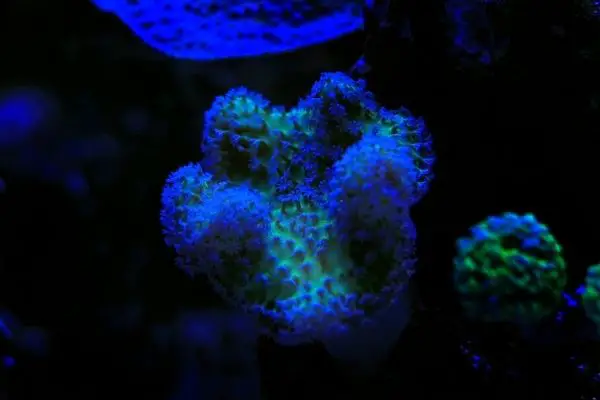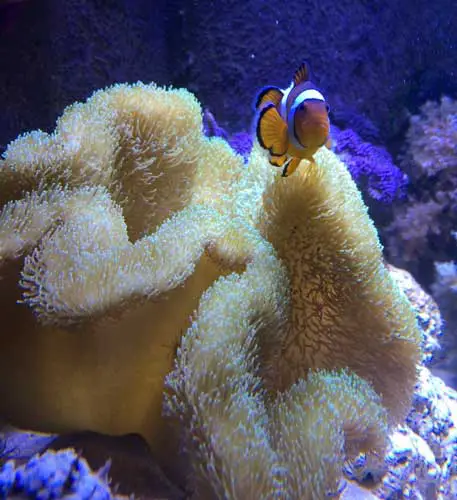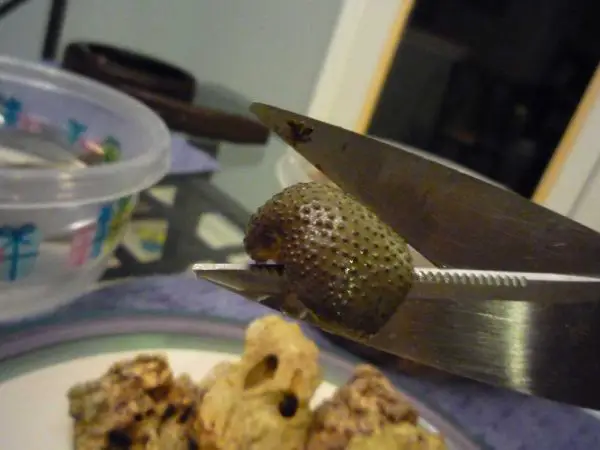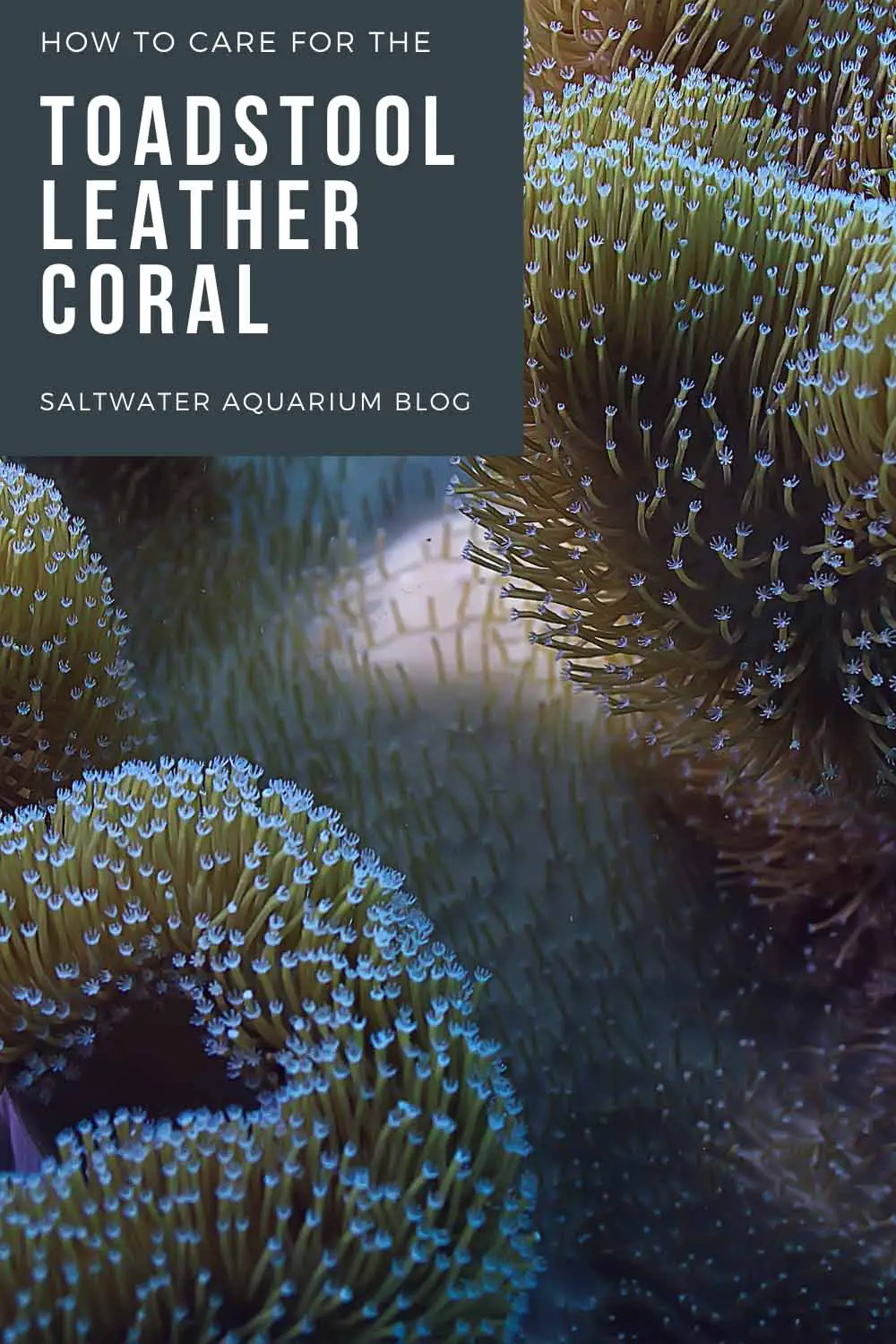The toadstool coral is a perfect beginner coral for saltwater aquariums. They are soft corals and require conditions typical for success in any reef tank. Toadstool corals belong to the leather coral group and are often sold in different varieties based on their color or the size of their polyps. Long polyps, short polyps, green polyps, and yellow Fiji leather are three commonly available varieties of toadstool coral.
Table of Contents: Toadstool Corals
Leather corals, in general, are interesting to add to reef tanks. And, out of that group, toadstool corals are easy to care for and fascinating to watch. If you want to narrow into a specific part of their care, you can select from the links below. Or you can stick through the entire article to make sure you’re not missing out on anything.
- Toadstool Corals: Why “Toadstools?”
- Natural Habitat of Toadstool Corals
- Care Requirements For Toadstool Corals
- Compatibility
- Is My Toadstool Coral Sick?
- Reproduction and Propagation
- Purchasing Toadstool Corals
- For More Information

Toadstool Corals: Why “Toadstools?”
The toadstool coral gets its name from the resemblance the smaller frags have to toadstool mushrooms. This is why you may also see them for sale at your local fish store as “mushroom corals.” Toadstool corals have a long stalk and a small mushroom cap top (called a capitulum). As the cap grows, it folds up and looks a bit like a carpet anemone.
When the polyps are fully extended, toadstool corals gain a fuzzy appearance. Every night – and a few times during the day – the toadstool will retract its polyps. This presents a smooth surface.

Natural Habitat for Toadstool Corals
The scientific name for toadstool corals gets tricky because it’s challenging to tell the different species apart. Most of the time, you’ll see them listed under the genus Sarcophyton spp. (In the case of the yellow Fiji leather, you’ll see the full scientific name of Sarcophyton elegans) But toadstools share the Alcyoniidae family with leather and mushroom corals. So you can also see Lobophtyum and Sinularia genera pop up at times. They go into the leather coral group due to the skin’s texture, which resembles (you’ll never guess) leather.
Toadstool corals are octocorals or octocorallians. This is a fancy way to say their polyps have 8 tentacles. Of course, you need to look close to count all of those tentacles on the polyps. But the abundance contributes to the “fuzzy” appearance you see when they’re open and waving around in the current.
Toadstool corals are found from the Fiji islands and throughout the Indian Ocean. Most often, they sun themselves in shallow water reefs and lagoons. They choose reefs mixed with both soft and hard corals. Shallow water reefs receive high-intensity light. So while we consider this coral to be a moderate-to-low light coral in the aquarium world (they tolerate lower levels of light than many corals, which we’ll touch on in a minute), there’s no reason to shy away from the beautiful toadstool if you have a high-intensity reef setup.

Care Requirements For Toadstool Corals
Toadstool corals are ideally suited to life in saltwater aquariums. As you can see below, the requirements fall in line with what you would expect in your average reef tank:
- Temperature: 72-78F/22.2-25.5C
- Specific Gravity: 1.023-1.025
- Lighting: Moderate
- Water Flow: Moderate
- pH: ~8.2
- Hardness: 8-12dKH

You’ll find that some websites report toadstool corals to benefit from the addition of strontium, iodine, and other trace elements. I’ve kept toadstool corals for years without direct supplementation. They get most of the nutrition they need from light and are much easier to care for than notoriously challenging species, like Gonipora or
They have photosynthetic dinoflagellates, called zooxanthellae, that live inside of them and convert light into life-sustaining sugars through photosynthesis. The corals are also thought to absorb nutrients directly from the water. So as long as you maintain a healthy tank environment, you don’t need to worry about struggling with supplements.
Do Toadstool Corals need to be fed?
Directly feeding a toadstool coral may increase the growth rate and vigor, but is not necessary to successfully keep them healthy in a saltwater tank. Toadstools will naturally absorb some nutrition from the water column without any intervention and symbiotic zooxanthellae cells will provide energy (sugar) to them via photosynthesis.
Placement in a Saltwater Tank: Where Do you Place Toadstool Corals?
It is generally best to place Toadstook Corals in the bottom region of the tank, on the sand bed, bottom glass, or lowest level of rocks, unless your aquarium lights are lower in intensity. These locations are generally lower light and moderate-to-lower flow, which is ideal for them.
I have historically had a deep sand bed in my 92-gallon (348L) tank. So that has meant placing my toadstool corals on the sandbed or mid-way up on rockwork, just on the perimeter of the light. Conditions may be slightly different for you.
Just know they don’t need the prime real estate you might otherwise reserve for your small polyp stony (SPS) corals. And if you put them in the twilight or darker regions of the tank? They may struggle. Reserve those areas for your non-photosynthetic sun coral polyps. You’ll still have ~60-70% of your tank that remains to play with.

A Note on Size
When you examine a toadstool coral frag in the fish store, you may assume you have plenty of room to play around with. However, these leather corals GROW when they’re provided with the proper conditions. And they have no problem swarming over available real estate. You need to make sure you take that into consideration when you start thinking about placement. If you don’t, you could find yourself struggling with “chemical warfare” down the road.
Don’t believe me? I grew a toadstool coral from a frag the size of a nickel to a colony with a cap that was at least 10 inches (25.4cm) in diameter!

How fast do they grow?
Toadstool corals are fast-growing. A small frag will grow significantly in size in just a few months. Be sure to give it plenty of room to grow.
Compatibility
Toadstool corals don’t have stinging cells or sweeper tentacles, like some of their LPS cousins, like Torches, Frogspawn, or Bubble Corals do. They also won’t try to digest their neighbors with toxic goo like Blastos, Acans and Favia might. By reef aquarium standards, they are generally peaceful tankmates. They DO produce more than FIFTY chemicals, though. And at least some of them are thought to harm the growth of certain SPS corals, and they may even fight cancer (Abdel-Lateff 2017).
Even though they share space alongside stony corals in the wild, you can find problems when you place the two in a home aquarium. This is why you need to think about size and placement so carefully.
Their first line of defensive chemicals, which is a defense mechanism they have in common with other leather corals, like the Cabbage coral. The mucus they secrete to protect themselves from bacteria, viruses, and algae. It’s helpful for the toadstool corals, and it even shows promise in human research. But the mucus ISN’T healthy for SPS corals, particularly the more sensitive species. A brush of a toadstool (or an accidental tumble of the cap) can result in a fatality.
Then you have the chemicals in the terpene family. Sound familiar? It should – they’re similar to the sticky substances you find in pine trees and termites! Toadstool corals use chemicals to prevent growth in and around their space. But if the levels build up within your tank? You can see death in SPS corals such as Acropora and Porites. And even the LPS Euphyllia can succumb!
You can help keep the terpenes in check by staying on top of your water changes – even if you only have ONE toadstool coral in your aquarium. And if you use activated carbon in your filters, that will absorb the compound, too. It’s a safe, natural way to keep the chemical warfare to a minimum.
Toadstool Corals: Surrogates for Sea Anemones?
Knowing all of that, doesn’t it seem strange to think that fish might flock to these chemical-prone leather corals? It’s true, though! Toadstool corals can make great anemone surrogates for clownfish. Clownfish are pretty needy houseguests. Once bonded, they need constant contact with the polyps of their host. But they also clean and peck at the polyps. (So, needy, but willing to do some light housework) Toadstool corals, in my experience, are fairly tolerant of all the attention. Some of the polyps WILL retract from the “clownfish love,” but I’ve had a pair living in a toadstool leather happily for several years now.

However, there are also reports that clownfish can irritate the coral so much that it eventually perishes. (If the polyps don’t open, the coral can’t feed) It’s important to watch the behavior of the two species together to ensure they are growing happily with each other.
In my tank, the clownfish have actually tried to lay eggs on the toadstool coral. It wasn’t an effective strategy. The eggs didn’t stick. You can see the ovipositor from the female clownfish in the picture below. It’s the blurry (sorry about that – bad photo) white triangle sticking out below the white stripe in the middle of the body. She rubbed and wiggled all over that poor coral for hours, trying to get the eggs to stay, and eventually laid a few on a nearby rock.

Is My Toadstool Coral Sick?
A toadstool coral will retract its polyps, clam up, and release a stringy, gross-looking mucus slime from time to time. The slime contains that mucus we already discussed. And the process is thought to be a way of removing detritus, algae, and other particles from the surface of the coral. Most times, this is harmless, but it can be an irritant to other corals. It’s usually the most sensitive members of the SPS group that get affected.
And if you get too much on your bare hands? You may get some irritation, too. If you feel compelled to reach into the tank and check on your toadstool corals during this phase, make sure you wear gloves. But, honestly, it’s a natural process. And while you won’t see those fuzzy polyps, there’s nothing wrong with your toadstools. They’re performing a cleansing routine to STAY healthy. Give them some time, and they’ll unfurl again.

Officially, this period is known as “shedding.” And while you don’t need to worry about picking up anything loose in the tank, it can scare aquarists who are unprepared.
Shedding
Any time a leather coral senses unwanted debris on the surface, it’s going to shed. Shedding starts with the polyps closing up for protection. Then you’ll see that “slime” coating appear. It can also appear wax-like, depending on your species of toadstool coral. The membrane will then slough off into the water. As the membrane sheds away, the polyps will start to reappear. They’re the coral’s “all clear” signal that everything’s clean again.
Shedding can last up to a week, depending on the size of your toadstool coral. And, again, it’s not a sign of sickness. Your coral’s actually PREVENTING illness.
Check out this YouTube video to see coral shedding in action.
Reproduction and Propagation
According to Borneman, in Aquarium Coral, a toadstool coral reaches maturity at around 6-10 years. Male colonies reach maturity faster and at a smaller size than female colonies (4 inches/10.2cm cubed vs. 24 inches/60cm cubed!!!) That’s a dramatic difference. And for female corals, that’s a significant size to support within your aquarium. I can’t wait for the toadstool corals in my home tank to become mature. (Better them than me!)
Toadstool corals can also make tiny clones of themselves by dropping bits of the cap or producing small buds from the side. The pieces then drift with the current and settle on a new attachment spot. If you’re counting on this propagation method, make sure you keep an eye on your tank. As the offspring are small and light, it’s easy for even a moderate water flow to sweep them to unsuitable spots in the tank. Then they won’t attach, and you’ll lose your new coral.

Luckily, these corals are also great candidates for fragging. Any small piece of the coral is capable of forming an entirely new full-sized colony. All you need is a sharp pair of scissors, as you can see in the image below.

Setting up your new frag takes some thought and patience, though. Toadstool Coral frags are slippery and slimy (that mucus thing) and won’t stick to live rock rubble with cyanoacrylate glue. Instead, I find that using the rubber band or plastic mesh methods (described in detail in How to Frag Corals) works best.
Purchasing them
Do you want your own toadstool coral? The best place to get one, in my opinion, is to make a trade for or purchase a frag from a fellow hobbyist in your area. That will give you the greatest chance of success while simultaneously costing you the least. Of course, you could also secure your specimen from a local fish store or online. If you do, try to get one raised via aquaculture rather than a wild-caught specimen.

Can you dip Toadstool corals?
Toadstool corals will tolerate Coral dip medication before introduction. Dipping is a recommended step prior to acclimating them to your reef tank, to prevent the introduction of unwanted parasites to your aquarium system.
What to read next
If you’re looking for a hardy, easy-to-care-for coral species, you definitely want to check out these other care guides:
For More Information
For more information about caring for the toadstool coral, check out this YouTube video:
For more information about setting up your own saltwater aquarium, I recommend The New Saltwater Aquarium Guide. To learn more about how to frag the toadstool coral, check out this step-by-step tutorial and pick up my book, How to Frag Corals, to learn additional tips and techniques about fragging any type of coral.

Written by Albert B. Ulrich III, Author of The Reef Aquarium Series of books.
Follow me on Twitter and Facebook
References
Abdel-Lateff, Ahmed, et al. “Antiproliferative effects of selected marine organisms collected from Red Sea.” Pakistan journal of pharmaceutical sciences 30.2 (2017): 381-386.
Borneman, Eric H. Aquarium Corals. Microcosm Ltd; 1st Printing Edition (March 1, 2001)
Ulrich III, Albert B. How to Frag Corals: Step-by-step guide to coral propagation and filling your frag tank with thriving polyps.www.SaltwaterAquariumBlog.com (January 20, 2015).
Ulrich III, Albert B. The New Saltwater Aquarium Guide.www.SaltwaterAquariumBlog.com (April 8, 2014)


Leave a Reply